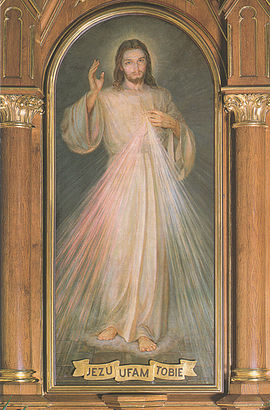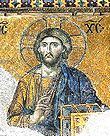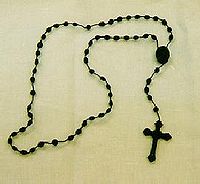- Chaplet of Divine Mercy
-
 The Painting of Divine Mercy by Adolf Hyla. The phrase at the bottom is Polish for "Jesus I trust in you."
The Painting of Divine Mercy by Adolf Hyla. The phrase at the bottom is Polish for "Jesus I trust in you."
The Chaplet of the Divine Mercy is a Roman Catholic devotion based on the visions of Jesus reported by Saint Mary Faustina Kowalska (1905-1938), known as "the Apostle of Mercy."[1][2] She was a Polish sister of the Congregation of the Sisters of Our Lady of Mercy and canonized as a Catholic saint in 2000.[3]
Faustina stated that she received the prayer through visions and conversations with Jesus, who made specific promises regarding the recitation of the prayers.[1] Her Vatican biography quotes some of these conversations.[3]
The chaplet is often said as a rosary-based prayer with the same set of rosary beads used for reciting the Holy Rosary or the Chaplet of Holy Wounds. However, the chaplet may also be said without beads, usually by counting prayers on the fingertips.[1] The chaplet may also be accompanied by the veneration of the Divine Mercy image.[4][5]
Contents
Origin, promises and recitations
On September 13, 1935, while Faustina was in Vilnius, she wrote of a vision of Jesus about the chaplet in her diary (Notebook 1 item 476).[6][7] Faustina stated that Jesus asked her to pray the chaplet and instruct others to do so. Although the chaplet is said on beads like the Rosary, it is about a third of the length of the Rosary, and unlike the Rosary that has evolved over the years, the form and structure of the chaplet has remained unchanged since Faustina attributed it to a message from Jesus.[7]
According to Faustina's visions, written in her diary, the chaplet's prayers for mercy are threefold: to obtain mercy, to trust in Christ's mercy, and to show mercy to others.[8][4][9]
Faustina wrote that Jesus promised that all who recite this chaplet at the hour of death or in the presence of the dying will receive great mercy. She wrote that Jesus said:
"....When they say this Chaplet in the presence of the dying, I will stand between My Father and the dying not as the just judge but as the Merciful Savior."
Faustina stated that Jesus also promised that anything can be obtained with this prayer if it is compatible with His will. In her diary Faustina recounted a vision on September 13, 1935 in which she saw an angel sent to a city to destroy it. Faustina began to pray for God's mercy on the city and felt the strong presence of the Holy Trinity.[9] After she prayed the internally-instructed prayers, the angel was powerless to harm the city. In subsequent visions, Faustina learned that the prayers she spoke were to be taught to all the people of the world.[10]
According to Roman Catholic tradition, the chaplet may be said at any time, but it is said especially on Divine Mercy Sunday and Fridays at 3:00 PM. The Chaplet is prayed daily at the National Shrine of The Divine Mercy in Stockbridge, Massachusetts. In the Philippines, Singapore, and Hong Kong the "3 o'clock Prayer" is broadcast on radio and television stations daily at 3:00 p.m. In 2000, Pope John Paul II ordained the Sunday after Easter Divine Mercy Sunday, where Roman Catholics remember the institution of the Sacrament of Penance. The hour Jesus died by crucifixion, 3:00 PM (15:00), is called the Hour of Mercy. In a novena, the chaplet is usually said each of the nine days from Good Friday to Divine Mercy Sunday.
Pope John Paul II was instrumental in the formal establishment of the Divine Mercy devotion and acknowledged the efforts of the Marian Fathers in its promotion in a Papal Blessing in 2001, the 70th anniversary of the revelation of the Divine Mercy Message and Devotion. Although the prayers said on the beads of the rosary chain share specific similarities in the Chaplet of Divine Mercy and the Chaplet of Holy Wounds, these are distinct chaplets and were introduced over 20 years apart, one in Poland, the other in France.[11]
The Divine Mercy devotion is also observed by the Universal Anglican Church.[12]
The chaplet
Part of a series of articles on
Roman Catholic
Devotions to Christ

Devotions
Holy Face
Sacred Heart
Divine Mercy
Eucharistic adoration
Holy Name
Holy Hour
Acts of Reparation
Holy Wounds
Rosary of Holy Wounds
Stations of the Cross
Precious Blood
Infant of PraguePrayers to Jesus
Anima Christi • Shoulder Wound • Morning offering • Sacred Heart prayer • Sacred Heart Consecration • You are Christ • Vianney's prayer • Perboyre's prayer • Montfort's prayer • Crucifix prayerThe chaplet begins by making the Sign of the Cross.[9] The chaplet has an optional opening prayer:
- "Thou didst expire, Lord Jesus, but the source of life gushed forth for souls, and the ocean of mercy opened up for the whole world. O Fount of Life, unfathomable Divine Mercy, envelop the whole world and empty Thyself out upon us."
And the following is repeated three times: "O Blood and Water, which gushed forth from the Heart of Jesus as a fountain of Mercy for us, I trust in Thee!"
There are then seven segments to the chaplet:
1. The Our Father
2. The Hail Mary
3. Recitation of the Apostles' Creed
4. On the large bead before each of the five decades (set of ten prayers) it is stated:
- "Eternal Father, I offer Thee the Body and Blood, Soul and Divinity of Thy Dearly Beloved Son, Our Lord, Jesus Christ, in atonement for our sins and those of the whole world."
5. On each of the 10 small "Hail Mary" beads it is stated:
- "For the sake of His sorrowful Passion, have mercy on us and on the whole world."
6. Items 2 and 3 are repeated for each of the decades.
7. The chaplet concludes with:
- "Holy God, Holy Mighty One, Holy Immortal One, have mercy on us and on the whole world."
The above prayer is repeated twice more.
There is also an optional concluding prayer:
- "Eternal God, in Whom mercy is endless and the treasury of compassion inexhaustible, look kindly upon us and increase Thy mercy in us, that in difficult moments we might not despair nor become despondent, but with great confidence submit ourselves to Thy holy will, which is Love and Mercy itself. Amen."
Novena of Divine Mercy
The Chaplet may be said alone or as part of a Novena.[13] Faustina wrote that in her visions Jesus instructed her that the Feast of the Divine Mercy (the Sunday after Easter) be preceded by a Divine Mercy Novena which would begin on Good Friday.
Faustina wrote that Jesus gave her a specific intention to pray for on each day of the 9 days of the Novena, and said that the last day would be the most difficult intention of all, namely to pray for the lukewarm and indifferent.[13] Faustina wrote that Jesus described these people as follows:
"These souls cause Me more suffering than any others; it was from such souls that My soul felt the most revulsion in the Garden of Olives. It was on their account that I said: 'My Father, if it is possible, let this cup pass Me by.' The last hope of salvation for them is to flee to My Mercy."[13]
Each of the 9 days of the novena thus asks for God's mercy for a specific group of people:[13]
-
- First Day - all mankind, in particular all sinners.
- Second Day - the souls of priests and the religious.
- Third Day - the souls of the devout and faithful people.
- Fourth Day - for the non-believers and those who do not yet know Jesus.
- Fifth Day - the souls of heretics and schismatics.
- Sixth Day - the souls of "the meek and humble" and for little children.
- Seventh Day - the souls of people who especially glorify Christ's mercy.
- Eighth Day - souls in Purgatory.
- Ninth Day - souls who have become lukewarm and indifferent.
Prayer groups
The Eucharistic Apostles of the Divine Mercy group is a community that holds regular meetings in which the Divine Mercy prayers are recited. There are groups all over the world, operated by different facilitators. In total there are 16 functioning EADM groups. They can be found at:[citation needed]
- Africa - Ghana, Kenya, Nigeria,Cameroon, Rwanda, Tanzania and Uganda
- Asia - India, Singapore, Philippines and Samoan Islands
- Australia - South Australia
- Europe - Portugal
- North America - Arizona, Florida, Texas, Saskatchewan and Toronto
- South America - Ecuador, Brazil
See also
- Divine Mercy Sunday
- Congregation of Marian Fathers
- St. Stanislaus Kostka in Chicago, the home of the Sanctuary of Divine Mercy
- John Paul II Institute of Divine Mercy
- Knights of Divine Mercy (Catholic men's group)
- Rosary based prayers
- Chaplet of Holy Wounds
Further reading
- Diary: Divine Mercy in My Soul by Faustina Kowalska 2003 ISBN 1596141107 (online version)
- Pope Benedict's Divine Mercy Mandate by David Came 2009 ISBN 9781596142039
References
- ^ a b c Ann Ball, 2003 "Encyclopedia of Catholic Devotions and Practices." ISBN 087973910X page 174
- ^ Pope John Paul II. "Homily for Faustina at Vatican website". http://www.vatican.va/holy_father/john_paul_ii/homilies/2002/documents/hf_jp-ii_hom_20020818_beatification-krakow_en.html.
- ^ a b Vatican Biography of Faustina Kowalska
- ^ a b Tim Drake, 2002, Saints of the Jubilee, Authorhouse ISBN 9781403310095 pages 85-95
- ^ Sourcebook for Sundays and Seasons 2008 by D. Todd Williamson 2007 ISBN 1568546173 page 195
- ^ Chaplet of Divine Mercy
- ^ a b A Divine Mercy Resource by Richard Torretto 2010 ISBN 1450232361 pages 63-79
- ^ Catherine M. Odell, 1998, Faustina: Apostle of Divine Mercy OSV Press ISBN 9780879739232
- ^ a b c EWTN on the Chaplet of Divine Mercy
- ^ Alan Butler and Paul Burns, 2005, Butler's Lives of the Saints, Burns and Oats ISBN 0860123839 page 251
- ^ G. P. Geoghegan, 2006, "A Collection of My Favorite Prayers." ISBN 9781411694576
- ^ Anglican website
- ^ a b c d EWTN on the Divine Mercy Novena
External links
- The decree of Roman Curia about the devotions in honour of Divine Mercy
- Chaplet of The Divine Mercy - TheDivineMercy.org
- Chaplet of Divine Mercy Online
- Audio of the Chaplet
- John Paul II; George W. Kosicki, C.S.B. (retranslation) (Nov. 30th, 1980). "Encyclical Rich in Mercy (Dives in Misericordia)". http://www.christendom-awake.org/pages/divinemercy/richinmercy1.htm. Retrieved 2011-11-03.
Wikimedia Foundation. 2010.

